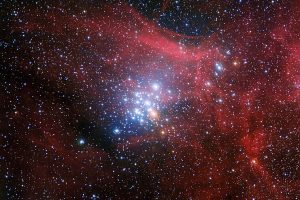Chemistry and rotation of the B stars in the stellar cluster NGC3293. The study: “The Gaia-ESO survey: A spectroscopic study of the young open cluster NGC 3293” of T. Morel (Université de Liège) appeared on A&A

Spectroscopic observations of massive stars (i.e., those more massive than 8 solar masses) allow astronomers to study their rapid evolution, which occurs on much shorter timescales compared to solar mass stars, and the impact of parameters such as stellar rotation on their evolution. To achieve this, observations of stellar clusters are greatly valuable, as they are groups of stars formed from the same molecular cloud. In fact, star clusters provide a rich sample of stars with the same age and covering a small area in the sky (which makes observations easier), but with a range of other properties such as mass and rotation. It is not surprising, then, that a large part of the Gaia-ESO survey has been dedicated to observing star clusters.
The Gaia-ESO Survey (GES) is a survey conducted with the FLAMES spectrograph, mounted on the Very Large Telescope of the European Southern Observatory. The more than 100000 stars observed in the framework of GES are divided into two main groups: field stars of the Milky Way and stars in clusters covering a wide range of properties, such as mass, age, position in the Galaxy, and chemical abundances. One cluster that received particular attention in GES is NGC3293, which is rich in massive stars and located at a distance of about 7800 light-years from the Sun. It is likely connected with the molecular complex of the Carina Nebula. Among the massive stars of NGC3293 are also blue and red supergiants, such as the stars HD91969 (spectral class B0 Ib) and V361 Car (M1.5 Iab).
From spectroscopic observations at high resolution, such as the GES observations, it is possible to derive precise information on the chemical abundances of stars and measure their rotational velocities. This is the objective of the team of researchers led by the astronomer T. Morel (STAR Institute, Université de Liège), which aims to measure the chemical abundances and rotational velocities of 160 B stars in NGC3293. The resulting distribution of rotational velocities of these stars peaks at about 200-250 km/sec, indicating that most of these stars rotate at 50%-60% of their critical velocity. The sample of rapidly rotating stars is dominated by stars with lower masses, while the most massive stars rotate more slowly. From a chemical point of view, two properties are particularly interesting: the paucity of stars with chemical peculiarities and that of stars showing high surface abundances of elements produced in the CN cycle (the cycle of thermonuclear reactions occurring in the core of massive stars which synthetizes helium from hydrogen). Both properties are explained in terms of the rotation of these stars: the former is due to the rapid rotation of the observed stars, while the latter can be explained in terms of the evolution of stars in the main sequence over a wide range of spin rates. The study is described in the paper “The Gaia-ESO Survey: A Spectroscopic Study of the Young Open Cluster NGC 3293” recently published in the journal Astronomy & Astrophysics, and it also presents a new estimate of the age of the cluster (20 million years). Among the coauthors is F. Damiani of INAF – Astronomical Observatory of Palermo.
The image (click here to visualize the entire figure) shows an image of NGC3293 obtained with the Wide Field Imager of the MPG/ESO 2.2-meters telescope at the La Silla observatory of the European Southern Observatory.
Mario Giuseppe Guarcello ( follow mariospiegacose) ( mariospiegacose) ( follow mariospiegacose)
Follow the Astronomical Observatory of Palermo on Facebok
Subscribe the Youtube channel of the Astronomical Observatory of Palermo
